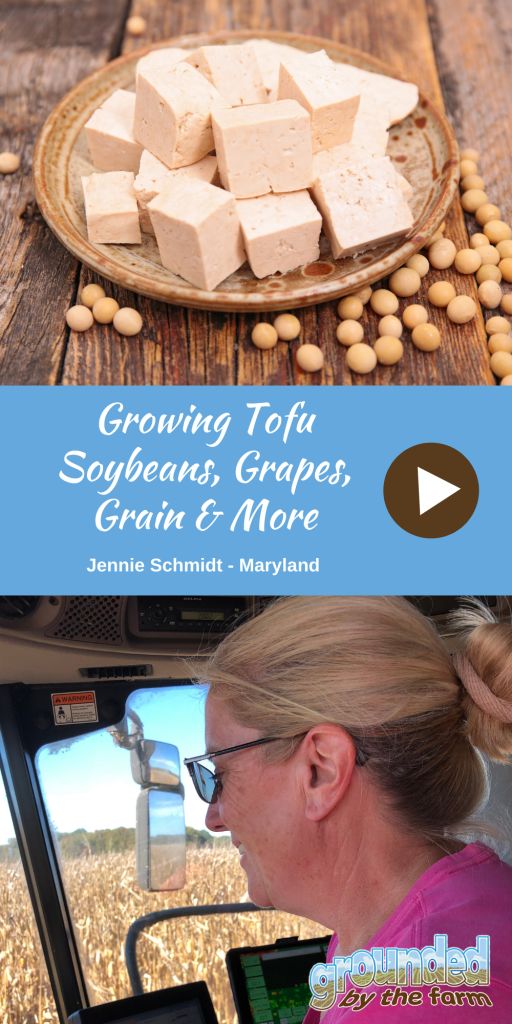As someone who loves an abundance of Asian cuisines, tofu may be on my plate or in my soup more than some Americans. But I haven’t had many chances to sit down and talk to someone about growing tofu soybeans. We can check that off the list as the conversation with Jennifer “Jennie” Schmidt about her family’s Maryland farm allowed us a chance to talk about diversification, how they determine what to plant, and more.
In 2021, they grew corn, soybeans, tofu soybeans, wine grapes and green beans for the fresh market. And a nephew is once again raising pigs on the farm. In the past they have grow several other crops including processing tomatoes (tomatoes that will be cooked down for sauces, etc). Understanding how farmers choose what to plant and how it has to be organized, is the central topic in this latest episode.
Note: An AI generated transcript of this episode is available at Talking Tofu with Jennie Schmidt.
 Background on Schmidt Farms
Background on Schmidt Farms
Jennie’s family farm — she points out it was her husband’s family farm before she got so involved — is on the Delmarva Peninsula, the Eastern Shore. Her husband and his brother were running the farm for the most part.
Jennie, who trained as a registered dietitian and worked at a hospital as an RD, got involved in the farm with wine grapes. She ended up planting some and doing custom work with some wineries and others in the state for several years before her husband Hans was approached about a job in the state’s department of agriculture, working with conservation programs. Jennie laughs and says she told Hans he needed to work that job for the benefits and next thing she knew, she was partnering with her brother-in-law Alan in the farm’s day-to-day!
For generations, the Schmidts have been looking at various options for the farm. They had pigs for a while and later focused on crops. Now a nephew is choosing to get back into pork. Jennie says they look at a lot of factors when they consider what mix to have on the farm — labor is a piece for some crops, the ability to partner with others who can supply the unique equipment needed for crops is a big piece as well. And like every farm, Jennie looks at the crops adapted to the environment, weather and soils that they are in.
Grain (corn, soybeans and wheat) play a big part in the operation as the poultry farms nearby need feed. Jennie says it’s probably for some people to believe now, but her favorite job is driving the combine for harvest. She puts hours a day in the seat for weeks on end and while she welcomed me joining for a couple of hours, for weeks on end. She says not only does she get a great feel for the results of the year, but it gives her time to think, listen to books, etc. I was lucky enough to join her in the combine for a ride this fall, here’s the video.
Choosing What to Grow
Jennie said labor, equipment, and the environment all play different parts in the decision of what to plant. And of course, knowing perennial crops like grapes, the commitment is for many years.
In fact, Jennie gave us a laundry list of some of the considerations on what goes where on the farm and some of the realities that can impact the choices they have.
Growing Tofu Soybeans
As I mentioned, I’m a fan of Asian cuisine and find the growing of tofu soybeans so interesting I asked a lot of questions! How they began growing them intrigued me though. Jennie pointed immediately to the geography she’s in. DC, Baltimore, Philadelphia and New York are all an easy drive and there are a number of companies specializing in Asian foods.
A group of farmers in the area formed a coop and went out seeking buyers when there was some question about the commitment to poultry in the area. The same equipment used for soybeans for grain can be used on these which was a great connection point. They also offer a high price for the crop. But alas, the market is only so big which means each farmer in the coop is given an allotment to plant rather than having endless opportunities to grow it. Jennie also mentions that harvest needs to be prioritized too as there can sometimes be some staining on soybeans and that is undesirable for tofu uses.
Growing Vegetables
As a registered dietitian, no doubt vegetable crops appeal to Jennie. They have planted tomatoes and green beans both in the hundreds of acres at a time. She points out that means harvesting several 18 wheelers full of either crop in a day. And which much of the crop management is easily done with irrigation that serves whatever is planted in the field, etc. The reality that specific planting and or harvesting equipment is needed means only planting the crops when contracts that also provide the expensive equipment and labor for the critical times. Planning allows farmers and the contractors to work together on timing so harvesting crews move from farm to farm.
Vegetable crops have rules that require the crop not be planted in the same field more than on a four year rotation, means long-term planning too! If you plant green beans in one field this year, you will be eligible to plant them there again in 4 years. Tomatoes have the same requirement. Limiting the likelihood of disease issues is the biggest reason for the requirement, which is a practice a lot of urban gardeners are familiar with!
Growing Wine Grapes
Growing grapes for wine is something that is a lot more common around the US now. Small acres are needed but the amount of labor required is high when it comes time to harvest. Jennie says they have expanded the vineyard and are growing several varietals. There are always more wineries interested she says, so the only limit is getting grapes harvested when needed. This was their biggest year ever and knowing there are some mechanized harvesters coming that will get tested, who knows what the future will do.
View this post on Instagram
Growing Grain
The largest acreage on Schmidt Farms is in grain — both corn and soybeans. It has a really good market locally with the number of chicken farms in Delmarva. The family likes to rotate corn and soybeans as corn contributes great organic matter for the soil — ie the plant parts that don’t get harvested stay in the field and biodegrade creating something like compost for future crops. And as legumes, soybeans add nitrogen to the soil.
Planting Cover Crops
The Schmidts also plant cover crops on the farm. Cover crops help improve soils, they are not harvested so they add a lot of organic matter. Jennie said wheat is planted as a cover as are a mix of radishes, rye, etc. She shared a photo of one of the tillage radishes she pulled in the vineyard to show her Instagram followers. They have the deep root and as Jennie points out, they can help reduce compaction and make it easier for roots to grow unrestricted.
View this post on Instagram
Find Jennie Online
Jenni can be found on social media in several places:




Does it involve getting rid of alot of weeds and other animals like squirrels and such animals that destroy the plants…. Just a curious reader…. Thanks..
There are definitely some reasons to keep the fields clear of weeds — not only do they compete with the plants for water, sunlight, nutrients, etc but weeds can cause issues with crop quality as well as yield. Damage from animals is usually not a big enough problem to have farmers focus on doing something about that but if an area has had a lot of land use changes like subdivisions going in, you can have trouble with food supply for wildlife that may lead to increased eating…. sadly that means wildlife will likely die of hunger at some point as most crops are usually only feed in one season.